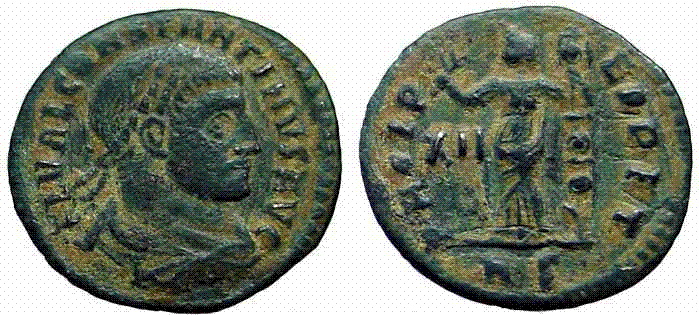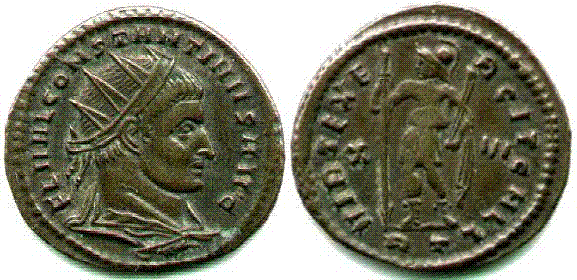
Fractions with Denominational
Marks
A summary of David Wigg's article¹

Fractions with Denominational
Marks
A summary of David Wigg's article¹
 |
 |
|
RIC VI Rome 355-358 PACI PERPET (XII) Pax standing left, holding standard. |
RIC VI Rome 359-360 VIRT EXERCIT GALL (XVI) Virtus leaning on a spear. |
In 312, Constantine defeated Maxentius and the mint in Rome began striking coins of the same standard as the Gallic mints. The follis was the standard type and it was minted at close to 1/72 libra (roughly 4.5 grams based on a Roman pound of 327 grams), and the size was roughly 21millimeters in diameter. The main reverse types were GENIO POPVLI ROMANI, MARTI CONSERVATORI, SOLI INVICTO COMITI, and SPQR OPTIMO PRINCIPI. Two fractionals were also struck at Rome during this period and both bear denominational marks.
"It will be argued here that the
fractions with the XII and XVI marks form a departure from the denominational
system of fractions previously struck at Rome, that the radiate crown was
used on the coins in order to identify a new denomination, and that the
numerals XII and XVI were intended to indicate the official values of the
new coins expressed in denarii." The weights of these two coins suggest
that they were intended to weigh 2/3 and 1/2 of the follis.
Bronze Coinage at Rome 312-313 A.D.
|
|
|
|
|
|
(RIC VI, 287-354) |
|
|
|
|
(RIC VI, (359-360) |
|
|
|
|
(RIC VI, 355-358) |
|
|
|
The follis is believed to have
had a value of 25 denarii, but the marks of value on these fractionals
suggest a value of 24 denarii for the follis.
The parallel use of 24 and 25 is a duodecimal and decimal system like the old English currency. The denominational marks of these fractionals suggests a value of not 25 denarii, but 24; 12 instead of 12 1/2, and 16 instead of 16 2/3. It was easier to count small change this way, and then convert to 25 units for larger amounts.
"When dealing with small numbers
the duodecimal system proves more flexible as it provides a wider variety
of subdivisions. But on the other hand the decimal system is more convenient
for multiplication of larger numbers."
Diocletian's
Edict of Prices also lends support to the theory that Romans used two
systems for their monetary system. For small amounts up to 25 DC, the denarii
communes is most frequently named as an even number-- 2, 4, 6, 8 etc.
Beginning at 25 DC, increments of 5, and more commonly 10, are used. This
chart stops at 100 DC, but the pattern of the decimal system continues
with the exception of 116 (1) and 144 (1); and two half-decimal occurrences
175 (9) and 274 (4).
The Frequency of Occurrence of Different Prices ²
|
denarii communes |
occurrences |
denarii communes |
occurrences |
|
|
|
|
|
|
|
|
|
|
|
|
|
|
|
|
|
|
|
|
|
|
|
|
|
|
|
|
|
|
|
|
|
|
|
|
|
|
|
|
|
|
|
|
|
|
|
|
|
|
|
|
|
|
|
|
|
|
|
|
|
|
|
|
|
|
|
|
|
|
|
|
|
|
|
|
|
|
|
|
¹ this page is a summary
of an excellent article by David Wigg.
David G. Wigg, "An Issue of Follis Fractions
with Denominational Marks by Constantine I at Rome," Die Münze.
Bild- Botschaft- Bedeutung. Festschrift für Maria R. Alfoldi.
Frankfort, Germany: Peter Lang, 1991, pp. 405-423.
² this data on Diocletian's
Price Edict came from the following article:
L. H. Cope, “Diocletian’s Price Edict
and its Associated Coinage Denominations.” Schweizer Münzblätter
27
(1977) : 7-11.
last modified on 29 July 2007